Z68 SSD Caching with Corsair's F40 SandForce SSD
by Anand Lal Shimpi on May 13, 2011 3:06 AM ESTAnandTech Storage Bench 2011 - Heavy Workload
Last year we introduced our AnandTech Storage Bench, a suite of benchmarks that took traces of real OS/application usage and played them back in a repeatable manner. I assembled the traces myself out of frustration with the majority of what we have today in terms of SSD benchmarks.
Although the AnandTech Storage Bench tests did a good job of characterizing SSD performance, they weren't stressful enough. All of the tests performed less than 10GB of reads/writes and typically involved only 4GB of writes specifically. That's not even enough exceed the spare area on most SSDs. Most canned SSD benchmarks don't even come close to writing a single gigabyte of data, but that doesn't mean that simply writing 4GB is acceptable.
Originally I kept the benchmarks short enough that they wouldn't be a burden to run (~30 minutes) but long enough that they were representative of what a power user might do with their system.
Not too long ago I tweeted that I had created what I referred to as the Mother of All SSD Benchmarks (MOASB). Rather than only writing 4GB of data to the drive, this benchmark writes 106.32GB. It's the load you'd put on a drive after nearly two weeks of constant usage. And it takes a *long* time to run.
First, some details:
1) The MOASB, officially called AnandTech Storage Bench 2011 - Heavy Workload, mainly focuses on the times when your I/O activity is the highest. There is a lot of downloading and application installing that happens during the course of this test. My thinking was that it's during application installs, file copies, downloading and multitasking with all of this that you can really notice performance differences between drives.
2) I tried to cover as many bases as possible with the software I incorporated into this test. There's a lot of photo editing in Photoshop, HTML editing in Dreamweaver, web browsing, game playing/level loading (Starcraft II & WoW are both a part of the test) as well as general use stuff (application installing, virus scanning). I included a large amount of email downloading, document creation and editing as well. To top it all off I even use Visual Studio 2008 to build Chromium during the test.
The test has 2,168,893 read operations and 1,783,447 write operations. The IO breakdown is as follows:
| AnandTech Storage Bench 2011 - Heavy Workload IO Breakdown | ||||
| IO Size | % of Total | |||
| 4KB | 28% | |||
| 16KB | 10% | |||
| 32KB | 10% | |||
| 64KB | 4% | |||
Only 42% of all operations are sequential, the rest range from pseudo to fully random (with most falling in the pseudo-random category). Average queue depth is 4.625 IOs, with 59% of operations taking place in an IO queue of 1.
Many of you have asked for a better way to really characterize performance. Simply looking at IOPS doesn't really say much. As a result I'm going to be presenting Storage Bench 2011 data in a slightly different way. We'll have performance represented as Average MB/s, with higher numbers being better. At the same time I'll be reporting how long the SSD was busy while running this test. These disk busy graphs will show you exactly how much time was shaved off by using a faster drive vs. a slower one during the course of this test. Finally, I will also break out performance into reads, writes and combined. The reason I do this is to help balance out the fact that this test is unusually write intensive, which can often hide the benefits of a drive with good read performance.
There's also a new light workload for 2011. This is a far more reasonable, typical every day use case benchmark. Lots of web browsing, photo editing (but with a greater focus on photo consumption), video playback as well as some application installs and gaming. This test isn't nearly as write intensive as the MOASB but it's still multiple times more write intensive than what we were running last year.
As always I don't believe that these two benchmarks alone are enough to characterize the performance of a drive, but hopefully along with the rest of our tests they will help provide a better idea.
The testbed for Storage Bench 2011 has changed as well. We're now using a Sandy Bridge platform with full 6Gbps support for these tests. All of the older tests are still run on our X58 platform.
AnandTech Storage Bench 2011 - Heavy Workload
We'll start out by looking at average data rate throughout our new heavy workload test:
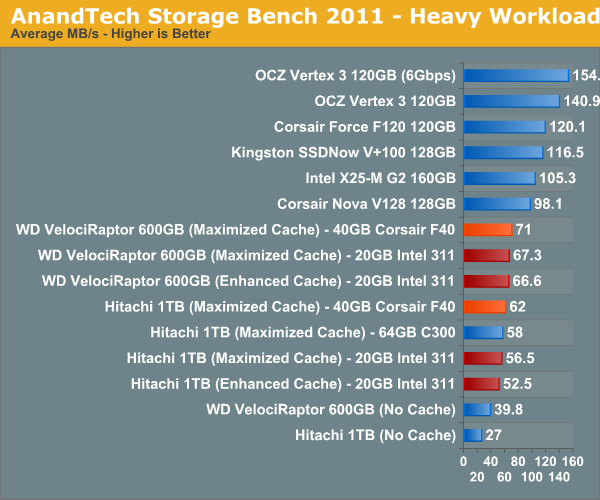
In our launch article we found that even Crucial's 64GB RealSSD C300 wasn't able to significantly outperform the 311, the situation isn't much different with the F40. The good news is that you do get twice the capacity and technically better performance, which could result in more of your data being in the cache at once.
The breakdown of reads vs. writes tells us more of what's going on:
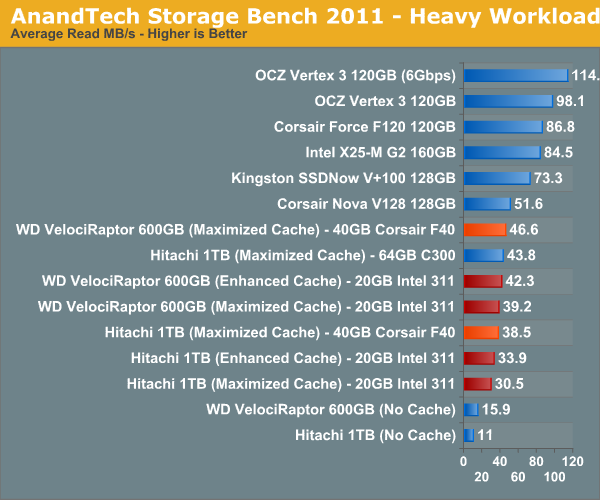
Read performance is actually where the F40 shines, surprisingly enough. This would imply that the majority of reads being cached are highly compressible in nature, playing to the F40's strengths. The write performance is a different story however:
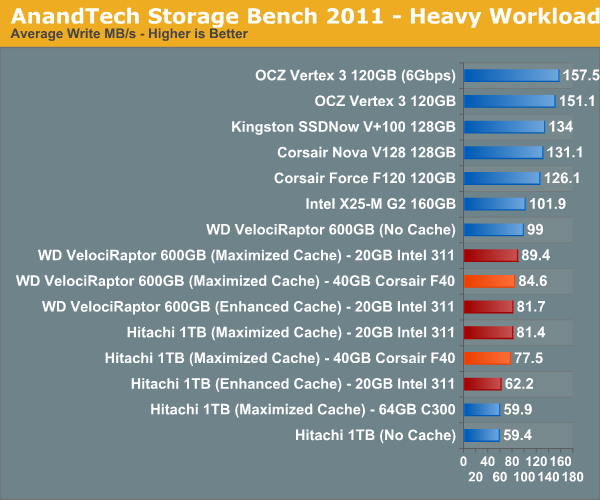
There isn't a huge difference here, but the 311 does pull ahead in the writes that occur during our test. Overall I'd say the F40 and 311 are pretty equal here, which is a good thing given the capacity advantage.
The next three charts just represent the same data, but in a different manner. Instead of looking at average data rate, we're looking at how long the disk was busy for during this entire test. Note that disk busy time excludes any and all idles, this is just how long the SSD was busy doing something:
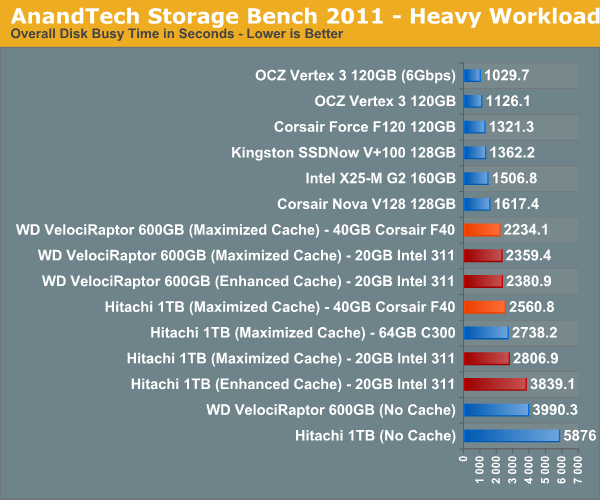

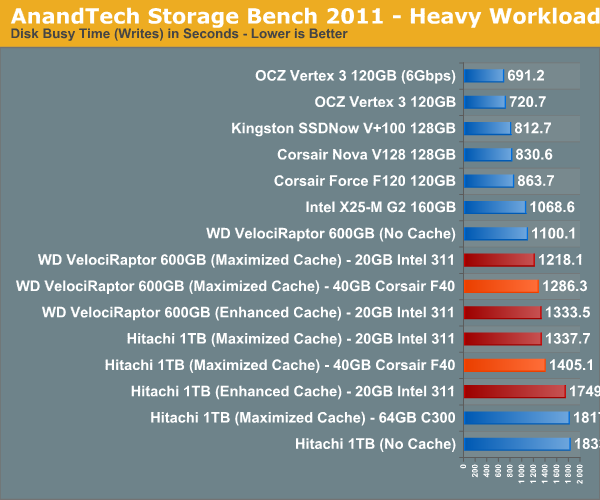










81 Comments
View All Comments
Dribble - Friday, May 13, 2011 - link
The reason being they are so common they are cheap. In the UK you can't get that 20GB Intel SSD yet, and while you could get the 40GB force (or vertex 2) the cost difference is very small - like I did you might as well get the 60GB vertex 2. I suspect a few others will do the same thing.Hence it would seem a good test.
The other thing I'd like to know is if you can buy a large capacity SSD (e.g. 240GB vertex 3) and then partition it giving 180GB to use as a boot drive, and the other 60GB to cache your monster games disk.
10Goto10 - Friday, May 13, 2011 - link
Or a 6Gb Sata Vertex3 240 GB, it should have enough IO, throughput and space to maintain both os and cache.Ryan Smith - Friday, May 13, 2011 - link
Yes, you can partition SSDs. In fact we've thrown around the exact same idea.10Goto10 - Friday, May 13, 2011 - link
According to the test hardware spec, the test is run on H67 not Z68, copy paste ;) ??mschira - Friday, May 13, 2011 - link
Would it be possible to get some SSD caching on a thinkpad t-series? they not only have a normal hard drive slot but they also have a miniPci slot for which they explicetly support small SSD to mount there...now having SSD caching would be great...
M.
DanNeely - Friday, May 13, 2011 - link
First page, the table lists an h67 mobo for the test, not a Z68jdavenport608 - Friday, May 13, 2011 - link
Both your articles about Z68 mention that SSD caching can be used in front of a RAID array. Do you plan on doing an article that describes the benefits or value of using a SSD cache in conjunction with different RAID arrays?weh69 - Friday, May 13, 2011 - link
I'd love to see results for a 60GB SSD as cache in front of a dual 2TB WD black RAID-1 array as the system drive.hechacker1 - Friday, May 13, 2011 - link
If that is possible, I would really like to see that too.Especially for a raid-5 config. Since write performance is limited so much by parity writes, having a cache could really help (on maximum mode).
kepstin - Friday, May 13, 2011 - link
This Intel SSD caching feature is a bit disappointing in one way.It's obvious that the caching work is done completely in software - in the Windows chipset driver, the same way as the motherboard RAID features work. There probably is some BIOS support required to boot off it though.
There's no technical reason why the same technology couldn't be used on other chipsets - it's just that Intel's decided to artificially limit it to the Z68...
I wouldn't be surprised if third-party tools and a generic Linux driver that can do the same thing on any chipset start showing up later this year.